The three-phase shunt reactor market is projected to grow from USD 1.5 billion in 2025 to USD 3 billion by 2035, registering a CAGR of 7.3% over the forecast period. Between 2025 and 2030, the market is expected to rise from USD 1.5 billion to USD 2.1 billion, driven by increasing demand for reactive power compensation in high-voltage transmission networks and grid stability solutions. Year-on-year analysis shows consistent growth, with values reaching USD 1.6 billion in 2026 and USD 1.7 billion in 2027, supported by infrastructure upgrades and the growing need for efficient power transmission. By 2028, the market is forecasted to reach USD 1.9 billion, advancing to USD 2.0 billion in 2029 and USD 2.1 billion by 2030. Growth will be further fueled by the increasing integration of renewable energy sources and the need for more sophisticated grid management systems. These dynamics position the three-phase shunt reactor market as a key enabler in the transition to a more stable, efficient, and sustainable electrical grid, with substantial opportunities for innovation and growth in global power transmission infrastructure.
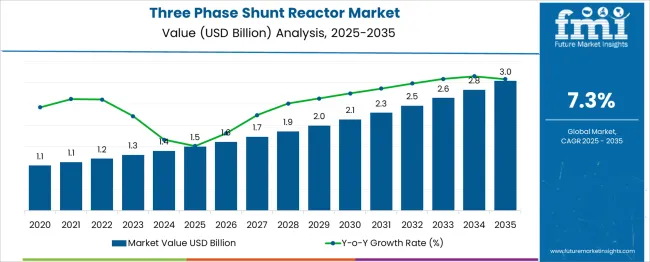
| Metric | Value |
|---|---|
| Three Phase Shunt Reactor Market Estimated Value in (2025 E) | USD 1.5 billion |
| Three Phase Shunt Reactor Market Forecast Value in (2035 F) | USD 3.0 billion |
| Forecast CAGR (2025 to 2035) | 7.3% |
The Three Phase Shunt Reactor market is witnessing steady growth, primarily driven by the global expansion of transmission networks, increased demand for voltage stabilization solutions, and higher reactive power management requirements in high-voltage systems. Utilities and grid operators are increasingly deploying shunt reactors to maintain voltage levels during low load conditions and minimize transmission losses.
The growing integration of renewable energy sources into conventional grids has intensified the need for reactive power compensation equipment, leading to sustained investment in three phase configurations that offer enhanced load balancing capabilities. Advances in digital monitoring, remote diagnostics, and insulation technologies are enhancing the reliability and operational efficiency of these systems.
Government-backed infrastructure initiatives in both developed and emerging economies, along with aging grid assets requiring replacement or retrofitting, are contributing to sustained adoption. Over the coming years, demand is expected to remain strong due to the critical role shunt reactors play in maintaining grid stability, especially as grid complexity increases with decentralization and distributed energy sources.
The three-phase shunt reactor market is segmented by insulation, product, end use, and region. By insulation, the market is divided into oil-immersed and air core. In terms of product, it is classified into fixed shunt reactors and variable shunt reactors. Based on end use, the market is segmented into electric utilities and renewable energy. Regionally, the three-phase shunt reactor industry is categorized into North America, Latin America, Western Europe, Eastern Europe, Balkan & Baltic Countries, Russia & Belarus, Central Asia, East Asia, South Asia & Pacific, and the Middle East & Africa.
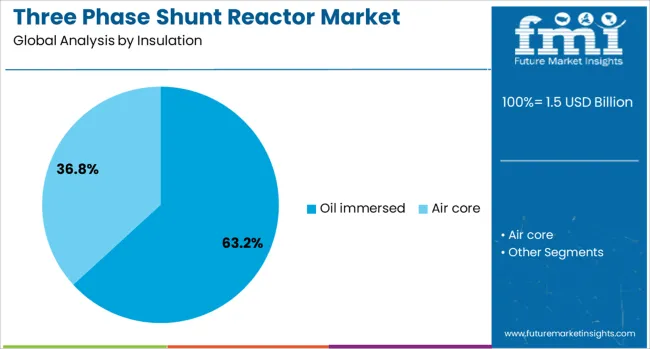
The oil immersed segment is anticipated to account for 63.2% of the Three Phase Shunt Reactor market revenue share in 2025. This dominant position is being supported by the superior cooling properties and long operational life of oil immersed reactors, which are essential for ensuring consistent performance under high electrical loads.
Their robustness in managing heat dissipation and insulation in outdoor, high-voltage environments has made them the preferred choice for transmission substations and long-distance power corridors. The segment's growth has also been reinforced by the continued preference of electric utilities for equipment with low maintenance needs and proven dielectric strength.
The compatibility of oil immersed shunt reactors with smart monitoring systems for temperature and pressure analysis has allowed utilities to enhance asset reliability and plan predictive maintenance schedules. As the push for efficient and sustainable energy infrastructure intensifies, oil immersed designs are being favored for their ability to provide long-term stability and cost efficiency in high-capacity power systems.
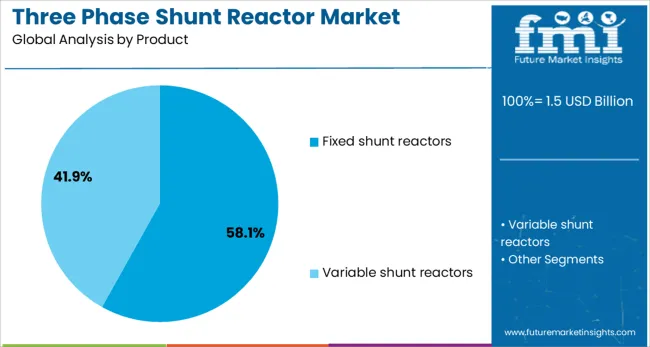
The fixed shunt reactors segment is projected to capture 58.1% of the revenue share in the Three Phase Shunt Reactor market in 2025. This segment’s growth has been influenced by the increasing need for consistent reactive power compensation in transmission systems, especially where load variations are minimal or predictable.
Fixed shunt reactors offer a simple and cost-effective solution for voltage regulation, particularly in grid infrastructures where dynamic adjustments are not frequently required. Their straightforward design and reliability have enabled wide deployment in high-voltage networks, especially in geographically spread-out or rural installations.
The segment has also benefited from the standardization of voltage support components in utility procurement practices, streamlining deployment and reducing commissioning time. With the expansion of power transmission projects and the focus on enhancing long-distance power flow efficiency, fixed shunt reactors continue to be adopted where grid reinforcement is essential but cost constraints and simplicity are prioritized.
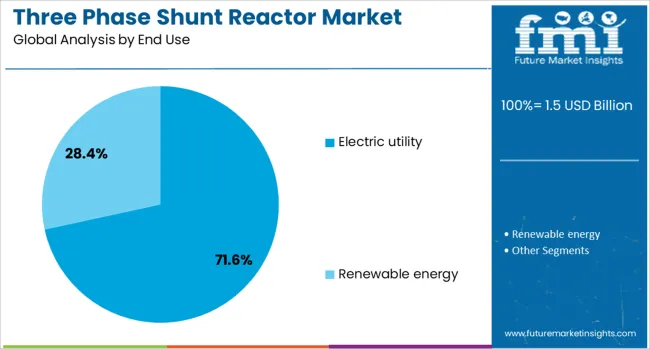
The electric utility segment is expected to represent 71.6% of the overall revenue share in the Three Phase Shunt Reactor market in 2025, underscoring its significant role in grid infrastructure. This segment's leading position is being reinforced by the escalating need to enhance transmission efficiency and stability in high-voltage electric networks.
Electric utilities are increasingly adopting shunt reactors to control overvoltage conditions during low load periods and to optimize reactive power flow, which is critical for maintaining grid balance. The increasing demand for electricity, combined with the integration of renewable sources such as wind and solar, has introduced complexity in voltage regulation, prompting utilities to deploy more reactors across substations.
The long operational lifespan, minimal intervention requirements, and improved diagnostics of modern three phase reactors have made them suitable for large-scale electric grids. As global grid operators aim to upgrade aging assets and improve reliability under fluctuating demand conditions, electric utilities will remain the primary end users of three phase shunt reactors, driving further market expansion.
The three-phase shunt reactor market is driven by the growing need for voltage regulation and system stability in electrical grids. Opportunities in grid expansion and renewable energy integration are accelerating demand, while trends toward high-efficiency, compact reactors are reshaping the market. However, high initial investment and operational costs remain challenges. By 2025, addressing these issues through more affordable and efficient solutions will be crucial for sustaining market growth and ensuring broader adoption.
The three-phase shunt reactor market is growing due to the increasing need for voltage regulation in power transmission and distribution systems. Shunt reactors are crucial in controlling the voltage levels, preventing overvoltage conditions, and improving system stability. The rise in energy demand and the expansion of electrical grids are driving the need for more efficient voltage regulation solutions. By 2025, the market will continue to benefit from the growth of electrical infrastructure and the need for reliable grid performance.
Opportunities in the three-phase shunt reactor market are increasing with the expansion of electrical grids and the integration of renewable energy sources. As renewable energy sources like wind and solar become more prevalent, there is a greater need for reactive power compensation to balance grid stability. Shunt reactors are critical for managing reactive power in these systems. By 2025, the growing integration of renewables and the expansion of smart grids will create substantial demand for shunt reactors to enhance grid performance.
Emerging trends in the three-phase shunt reactor market include the growing demand for high-efficiency and compact reactors. As power systems become more complex and space constraints increase, there is a shift toward designing smaller and more efficient reactors. These advanced reactors provide the same performance as traditional models but with reduced size and energy losses. By 2025, these trends are expected to dominate, offering solutions that improve grid stability while optimizing space and energy consumption.
Despite market growth, challenges related to high initial investment and operational costs persist. The cost of manufacturing and installing three-phase shunt reactors can be substantial, which may limit their adoption in smaller or budget-constrained projects. Additionally, the ongoing maintenance and operational costs associated with these reactors, particularly in complex grid systems, can impact their financial feasibility. By 2025, addressing these challenges through cost-effective manufacturing and improved operational efficiency will be crucial for wider market penetration.
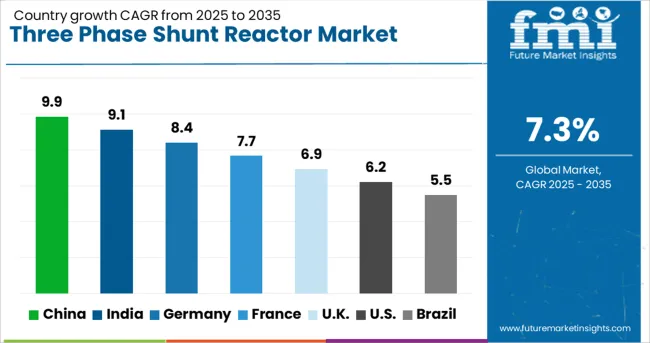
| Country | CAGR |
|---|---|
| China | 9.9% |
| India | 9.1% |
| Germany | 8.4% |
| France | 7.7% |
| UK | 6.9% |
| USA | 6.2% |
| Brazil | 5.5% |
The global three phase shunt reactor market is projected to grow at a 7.3% CAGR from 2025 to 2035. China leads with a growth rate of 9.9%, followed by India at 9.1%, and Germany at 8.4%. The United Kingdom records a growth rate of 6.9%, while the United States shows the slowest growth at 6.2%. These varying growth rates are driven by factors such as the increasing demand for reactive power compensation, grid stability, and the expansion of electrical networks in emerging economies. Emerging markets like China and India are witnessing higher growth due to rapid industrialization, urbanization, and the need to stabilize power grids, while more mature markets like the USA and the UK experience steady growth driven by upgrades to existing electrical infrastructure and increasing investments in renewable energy integration. This report includes insights on 40+ countries; the top markets are shown here for reference.
The three phase shunt reactor market in China is growing rapidly, with a projected CAGR of 9.9%. China’s expanding electrical grid infrastructure, driven by urbanization, industrial growth, and the increasing integration of renewable energy sources, is fueling the demand for shunt reactors. The country’s focus on improving grid stability and reactive power compensation, particularly in rural and underserved areas, further supports market growth. Additionally, China’s continued investment in renewable energy, including wind and solar power, necessitates the use of shunt reactors to manage grid fluctuations and maintain power quality, contributing to significant market demand.
The three phase shunt reactor market in India is projected to grow at a CAGR of 9.1%. India’s rapidly growing energy demand, combined with the expansion of electrical infrastructure and the increasing focus on grid reliability, is driving the adoption of shunt reactors. The need for efficient reactive power compensation in both urban and rural areas is a key factor contributing to market growth. Furthermore, India’s growing investments in renewable energy sources, particularly wind and solar, are increasing the demand for shunt reactors to manage power fluctuations and ensure grid stability, making the market highly attractive for future growth.
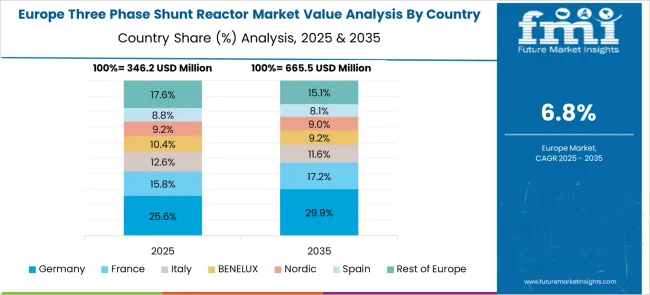
The three phase shunt reactor market in Germany is projected to grow at a CAGR of 8.4%. Germany’s well-established power grid and emphasis on renewable energy integration are driving demand for shunt reactors. The country’s focus on stabilizing the grid and compensating for reactive power in industrial and residential sectors is contributing to market growth. Additionally, Germany’s commitment to sustainability, energy efficiency, and the transition to green energy sources, including wind and solar power, necessitates the use of shunt reactors to maintain grid stability and reduce power losses, further driving market adoption.
The three phase shunt reactor market in the United Kingdom is projected to grow at a CAGR of 6.9%. The UK is witnessing steady demand for shunt reactors as the country expands its electrical grid infrastructure and integrates more renewable energy sources. The increasing need for grid stabilization and the management of reactive power is driving adoption, particularly as the UK transitions toward a low-carbon economy. Additionally, government policies promoting energy efficiency and renewable energy integration are contributing to the growth of the market, particularly in the commercial and industrial sectors.
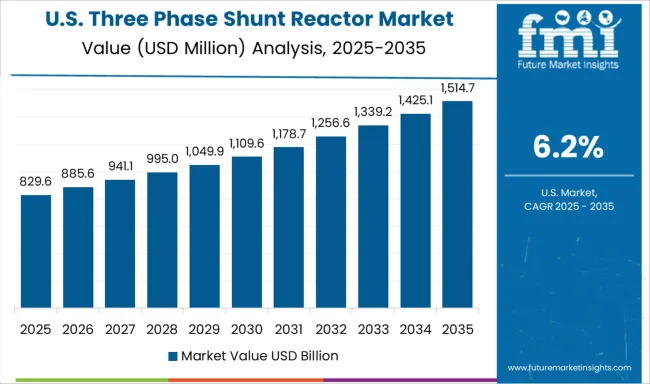
The three phase shunt reactor market in the United States is expected to grow at a CAGR of 6.2%. The USA market is driven by the increasing need for grid stability and reactive power compensation in both urban and rural areas. The country’s expanding renewable energy sector, including wind and solar power, is a major factor contributing to the market’s growth, as shunt reactors are crucial in stabilizing the grid and managing power fluctuations. Additionally, the ongoing upgrades to the USA electrical grid infrastructure, along with the focus on reducing energy losses and improving efficiency, are supporting continued demand for shunt reactors.
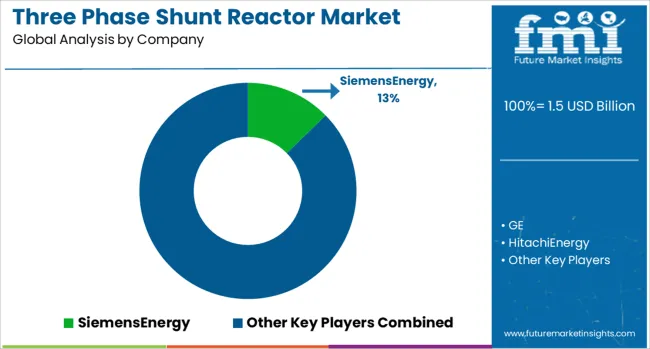
The three-phase shunt reactor market is dominated by Siemens Energy, which leads with its advanced shunt reactors designed to enhance power quality, maintain system stability, and optimize grid operations. Siemens Energy’s dominance is supported by its extensive portfolio of high-efficiency shunt reactors used in transmission networks, particularly in high-voltage applications.
Key players such as GE, Hitachi Energy, and Hyosung Heavy Industries maintain significant market shares by offering reliable and cost-effective shunt reactors that improve power factor correction and voltage regulation. These companies focus on delivering durable, efficient solutions that meet the growing demand for stable and reliable energy in power grids worldwide.
Emerging players like CG Power & Industrial Solutions, Toshiba Energy Systems & Solutions, and Fuji Electric are expanding their market presence by providing specialized shunt reactor solutions for niche applications such as renewable energy integration and grid balancing in emerging markets. Their strategies include improving the design for higher efficiency, offering more compact solutions, and focusing on sustainability.
| Item | Value |
|---|---|
| Quantitative Units | USD Billion |
| Insulation | Oil immersed and Air core |
| Product | Fixed shunt reactors and Variable shunt reactors |
| End Use | Electric utility and Renewable energy |
| Regions Covered | North America, Europe, Asia-Pacific, Latin America, Middle East & Africa |
| Country Covered | United States, Canada, Germany, France, United Kingdom, China, Japan, India, Brazil, South Africa |
| Key Companies Profiled | Siemens Energy, GE, Hitachi Energy, Hyosung Heavy Industries, CG Power & Industrial Solutions, Toshiba Energy Systems & Solutions, Fuji Electric, WEG, Nissin Electric, SGB-SMIT Group, GETRA, GBE, HICO America, Shrihans Electricals, TMC Transformers |
| Additional Attributes | Dollar sales by reactor type and application, demand dynamics across power transmission, distribution, and industrial sectors, regional trends in three-phase shunt reactor adoption, innovation in energy efficiency and reactive power compensation technologies, impact of regulatory standards on grid stability and safety, and emerging use cases in renewable energy integration and voltage regulation. |
The global three phase shunt reactor market is estimated to be valued at USD 1.5 billion in 2025.
The market size for the three phase shunt reactor market is projected to reach USD 3.0 billion by 2035.
The three phase shunt reactor market is expected to grow at a 7.3% CAGR between 2025 and 2035.
The key product types in three phase shunt reactor market are oil immersed and air core.
In terms of product, fixed shunt reactors segment to command 58.1% share in the three phase shunt reactor market in 2025.






Our Research Products

The "Full Research Suite" delivers actionable market intel, deep dives on markets or technologies, so clients act faster, cut risk, and unlock growth.

The Leaderboard benchmarks and ranks top vendors, classifying them as Established Leaders, Leading Challengers, or Disruptors & Challengers.

Locates where complements amplify value and substitutes erode it, forecasting net impact by horizon

We deliver granular, decision-grade intel: market sizing, 5-year forecasts, pricing, adoption, usage, revenue, and operational KPIs—plus competitor tracking, regulation, and value chains—across 60 countries broadly.

Spot the shifts before they hit your P&L. We track inflection points, adoption curves, pricing moves, and ecosystem plays to show where demand is heading, why it is changing, and what to do next across high-growth markets and disruptive tech

Real-time reads of user behavior. We track shifting priorities, perceptions of today’s and next-gen services, and provider experience, then pace how fast tech moves from trial to adoption, blending buyer, consumer, and channel inputs with social signals (#WhySwitch, #UX).

Partner with our analyst team to build a custom report designed around your business priorities. From analysing market trends to assessing competitors or crafting bespoke datasets, we tailor insights to your needs.
Supplier Intelligence
Discovery & Profiling
Capacity & Footprint
Performance & Risk
Compliance & Governance
Commercial Readiness
Who Supplies Whom
Scorecards & Shortlists
Playbooks & Docs
Category Intelligence
Definition & Scope
Demand & Use Cases
Cost Drivers
Market Structure
Supply Chain Map
Trade & Policy
Operating Norms
Deliverables
Buyer Intelligence
Account Basics
Spend & Scope
Procurement Model
Vendor Requirements
Terms & Policies
Entry Strategy
Pain Points & Triggers
Outputs
Pricing Analysis
Benchmarks
Trends
Should-Cost
Indexation
Landed Cost
Commercial Terms
Deliverables
Brand Analysis
Positioning & Value Prop
Share & Presence
Customer Evidence
Go-to-Market
Digital & Reputation
Compliance & Trust
KPIs & Gaps
Outputs
Full Research Suite comprises of:
Market outlook & trends analysis
Interviews & case studies
Strategic recommendations
Vendor profiles & capabilities analysis
5-year forecasts
8 regions and 60+ country-level data splits
Market segment data splits
12 months of continuous data updates
DELIVERED AS:
PDF EXCEL ONLINE
Single Phase Shunt Reactor Market Size and Share Forecast Outlook 2025 to 2035
Single Phase Variable Shunt Reactor Market Size and Share Forecast Outlook 2025 to 2035
Three-Phase Unbalanced Regulating Device Market Size and Share Forecast Outlook 2025 to 2035
Three Phase Commercial Voltage Regulator Market Size and Share Forecast Outlook 2025 to 2035
Three Phase String Inverter Market Size and Share Forecast Outlook 2025 to 2035
Three Phase Inverter Market Size and Share Forecast Outlook 2025 to 2035
Three Phase Residential Voltage Regulator Market Size and Share Forecast Outlook 2025 to 2035
Three Phase Recloser Market Size and Share Forecast Outlook 2025 to 2035
Three Phase Green Power Transformer Market Size and Share Forecast Outlook 2025 to 2035
Three Phase Micro Inverter Market Size and Share Forecast Outlook 2025 to 2035
Three Phase Residential Power Conditioner Market Size and Share Forecast Outlook 2025 to 2035
Three Phase Power Device Analyzer Market Size and Share Forecast Outlook 2025 to 2035
Shunt Reactor Market Growth – Trends & Forecast 2020 to 2030
Fixed Shunt Reactor Market Size and Share Forecast Outlook 2025 to 2035
On-grid Three Phase PV Inverter Market Size and Share Forecast Outlook 2025 to 2035
Variable Shunt Reactor Market Size and Share Forecast Outlook 2025 to 2035
Standalone Three Phase PV Inverter Market Size and Share Forecast Outlook 2025 to 2035
Air Cooled Three Phase Home Standby Gensets Market Size and Share Forecast Outlook 2025 to 2035
Commercial Three Phase Micro Inverter Market Size and Share Forecast Outlook 2025 to 2035
Controllable Shunt Reactor for UHV Market Size and Share Forecast Outlook 2025 to 2035

Thank you!
You will receive an email from our Business Development Manager. Please be sure to check your SPAM/JUNK folder too.
Chat With
MaRIA